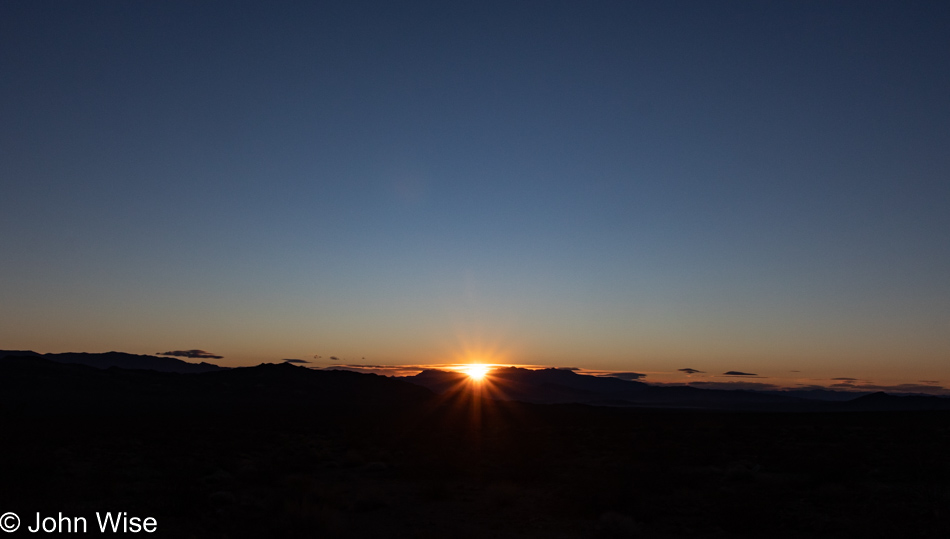
We have reservations we grabbed at the last minute just a few days ago that will be taking us off the proverbial beaten path; it was a lucky score, considering this is the popular time of year to visit Death Valley National Park. An alarm was required to wake us before the sun returned, as we were at least an hour from our meeting point at Furnace Creek. A hot breakfast wasn’t going to be an option here in Shoshone with its one cafe that opens at 8:00; good thing we came prepared. With the essentials out of the way, we were underway.
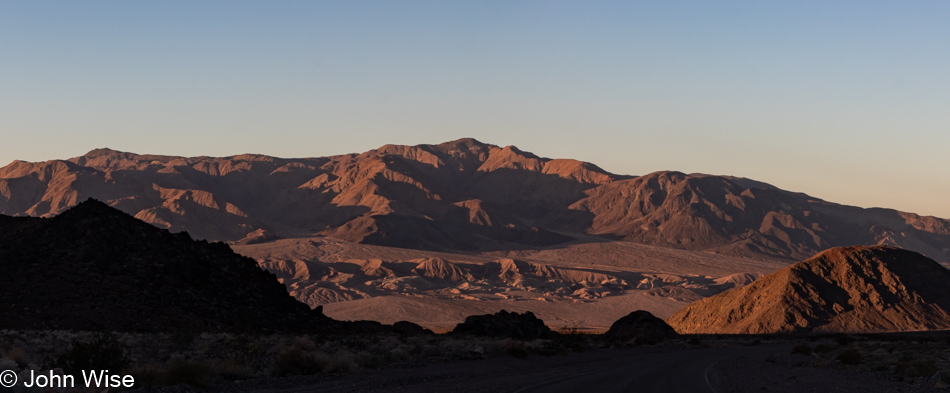
Leaving ourselves plenty of time to dawdle for the sake of taking photos, we took a quick left on Jubilee Pass Road, which at 72 miles to Furnace Creek is slightly more than the 57 miles we had driven through Death Valley Junction outside the park but the path we’ve chosen is definitely the more scenic way even if it takes nearly twice as long.
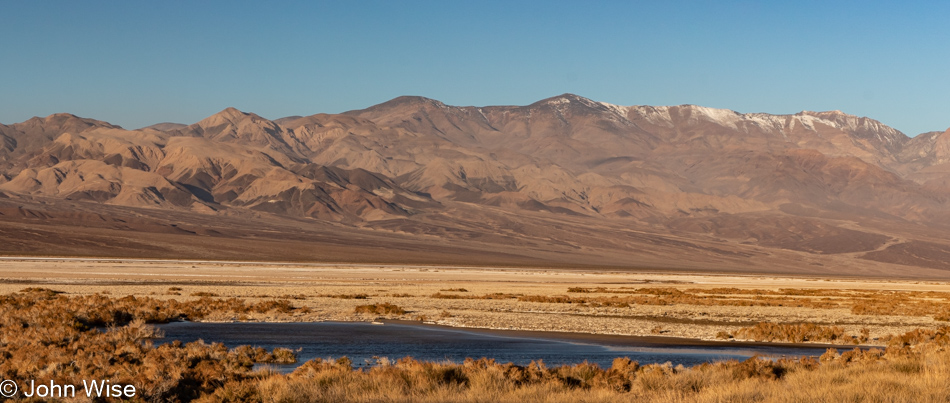
We reset the odometer as we turned away from Shoshone in the hopes that if we knew how many miles still lay ahead of us, we could better manage how many stops we could make along the way. In the distance is the southern end of the Panamint Range of mountains, which is also the western park barrier, but the taller peaks are further north. What we were most interested in was the amount of water we were seeing in this small pool.
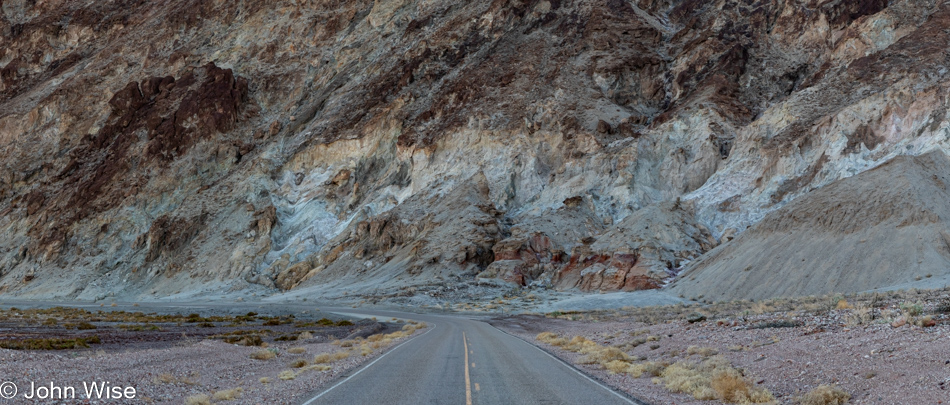
In the afternoon sun, the brilliant colors of the Amargosa Range come to life, illuminating the extraordinary variety of minerals that constitute the mountains on the eastern side of Death Valley here on the southern end.

Reaching Badwater Basin, we just had to get out for a short walk here at 283 feet below sea level. On a previous visit to Death Valley, we arrived well before sunrise and walked out what felt like forever but was likely well less than 2 miles of the 5-mile wide valley floor. Still, in shadow, we awaited the sun’s arrival and then walked back as the salt pan turned crispy, clean white with the sunlight slowly crawling along at our snail’s pace. Today, there’s not a lot of pure white salt out there, probably due to not having any rain of consequence in addition to the wind-driven sands that can hide that particular view of the salt.
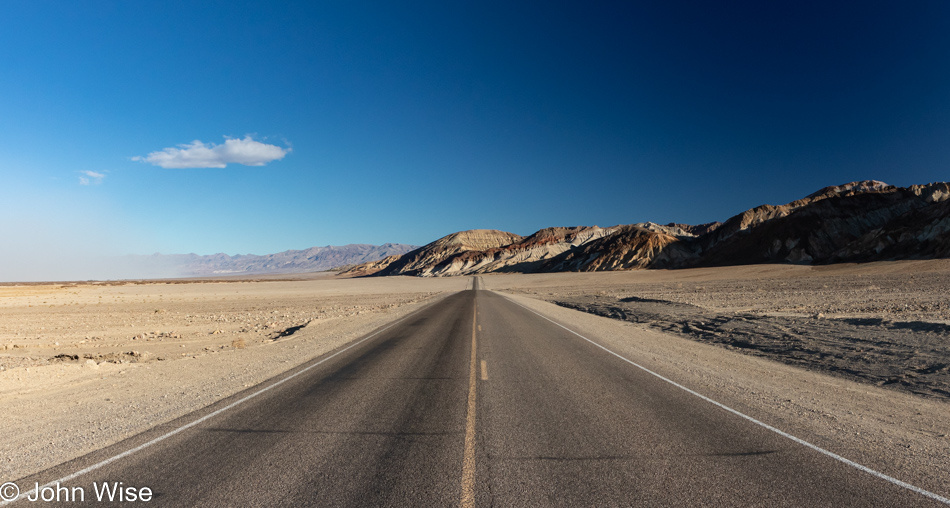
We are on the last stretch of driving before we park the car and jump into a jeep at Furnace Creek. Look to the left, and you can see the effect of the wind kicking up sand over the Mesquite Flat Sand Dunes.
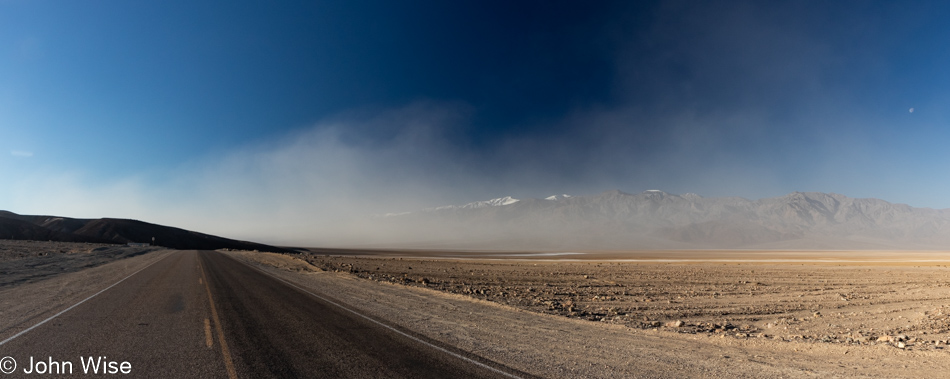
This was the view looking back south just as the air quality was starting to get really bad.
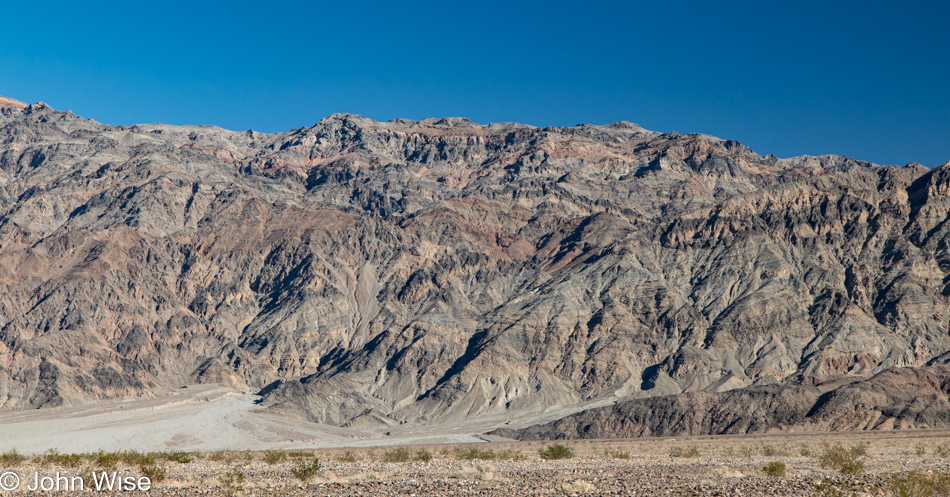
Lucky us that just past the sand dunes things cleared up. We met up with Hal, our driver for the mystery tour I’ve been alluding to, got into the Jeep, and drove 200 feet around the corner to pick up lunch at a small gift shop and store. Loaded up with sandwiches, some fresh fruit, and a couple of cups of café de olla (some super yummy Mexican coffee), we were ready to continue our trek north.

Our guide shares an incredible history culled from his adventures as a helicopter pilot in the Vietnam War, where he earned five purple hearts, his love of photography and Death Valley, a friendship with Art Bell, who was also from Pahrump, Nevada, and some wild adventures where he delivered Cessna’s, with extra fuel tanks, to Australia via a series of island hopping starting with Hawaii.
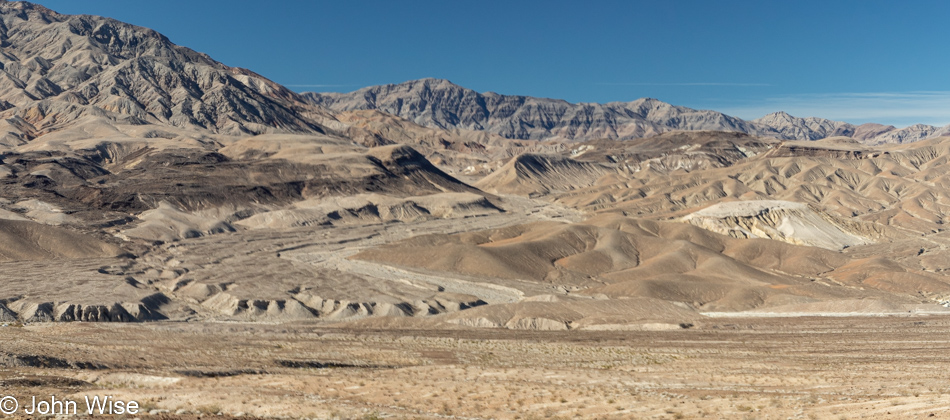
While Hal still owns a helicopter to this day, it’s his intense love of this national park that seems to drive him. I doubt there’s a place in Death Valley he’s not visited. From his enthusiasm for the drive-through Titus Canyon, we now have something new to look forward to on a future visit to this corner of California.
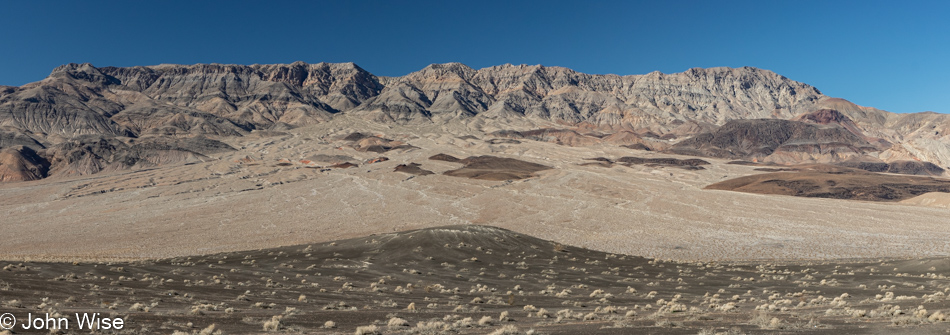
Our drive from Furnace Creek to the turn-off for our next stop is 56 miles, but we are finally approaching a very iconic part of Death Valley we’ve waited more than a dozen years to visit. We are excited to be here at this juncture, though we still have 27 miles of bumpy sandy road to cover, which is the reason we needed someone with a 4-wheel drive high clearance vehicle to get us out here.
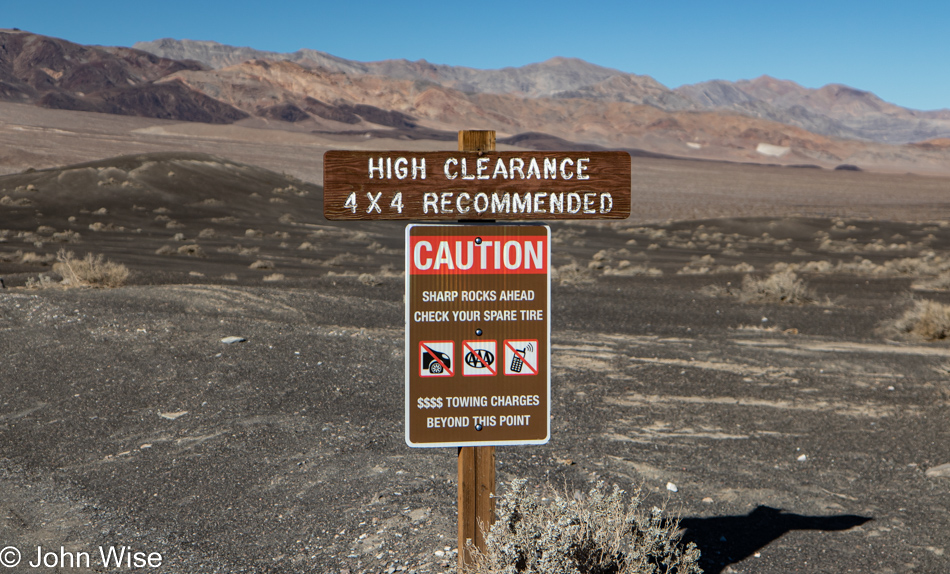
Intention plays an important role in opening doors to finding surprises. Back on December 3rd of last year, I started an exercise that began with an empty spreadsheet. The idea was to best the number of travels we took back in 2004 when we hit a personal record of 22 excursions out of Phoenix. With 2022 around the corner, I wondered if we could squeeze more than that into this upcoming year. Knowing that we were going to the Bosque del Apache National Wildlife Refuge in New Mexico over Christmas, I simply went out two weeks from that and figured a quick weekend trip to Los Angeles would be a good starting point to launch into bi-monthly travels.
Well, this is the second trip in that series that kicked off just two weeks ago, and it so happened that on our way back from L.A., Caroline brought up how one day we should figure out how to get out to Racetrack Playa in Death Valley, I’m sure she was thinking of this national park as she knew as we were driving south of it on the way home that we were visiting in two weeks. We already had the experience of knowing that our car was never going to bring us out there, so I told her to search for tours of the place. She came up with Farabee’s Jeep Tours, but I misunderstood the pricing, and so shortly before our visit, I figured we’d never be able to book the trip, so I didn’t even try.
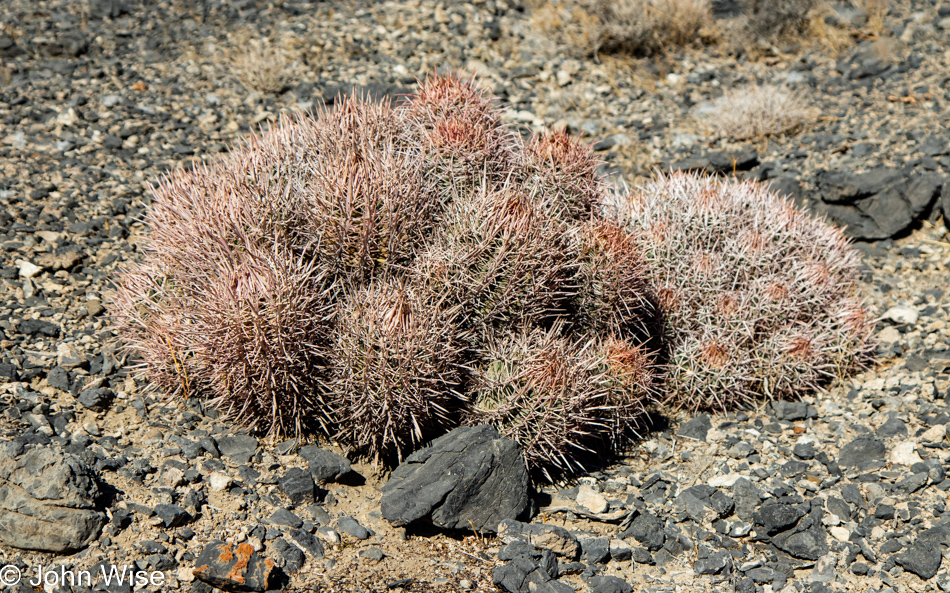
This past week, just Tuesday actually, I decided to call Farabee’s and see if anything at the last minute might be available. To my great surprise, the Saturday tour out to Racetrack Playa hadn’t sold out, and there was someone available who’d take us. The point I’ve wanted to make here is that my exercise of setting 24 getaways created the mental space of anticipating just what we’d do on each of those, but without those mileposts ahead of us, would we have even considered options for any given upcoming weekend?
Another example came up yesterday on our drive north as we started discussing what we might do while at the Grand Canyon. I thought we’d consider the Hermit’s Rest Trail as we’ve never been on it, but it turns out that there are spots with enough exposure that people with acrophobia would be smart to take into consideration. Well, then, it’s a good thing I still have nearly two weeks to go before we get there. Do not leave everything up to chance; create intentions, put things into a document, and then explore how and what you’ll do once you think that thing might be worthwhile.
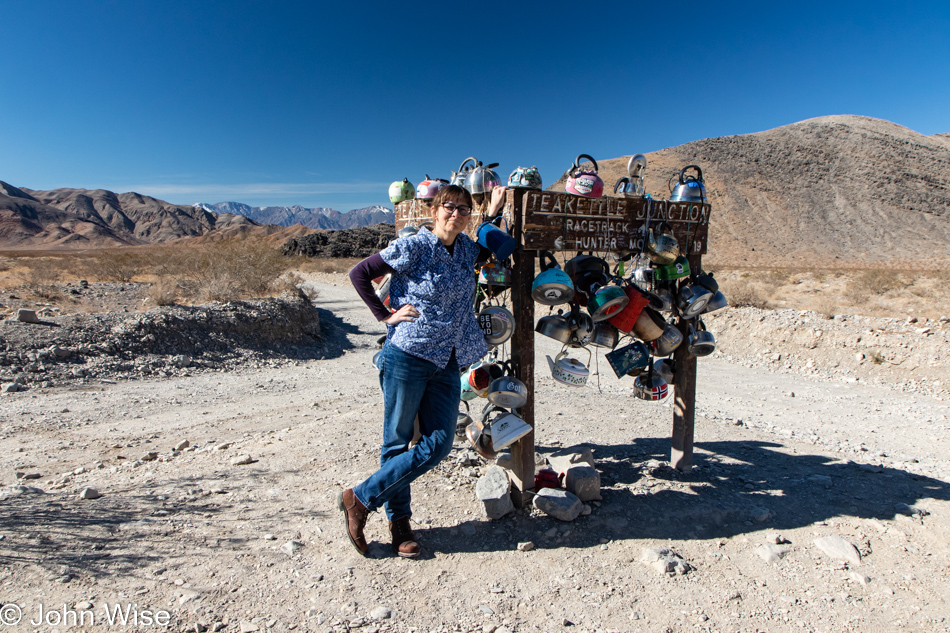
Eighteen years ago, on the 6th of July, 2004, Caroline and I, on a 118-degree day in the shade, drove down a northern dirt road entry into Death Valley. From Big Pine to Furnace Creek, our 105-mile 4-hour journey had us passing the famous Crankshaft Junction (click here to see that blog post). Today, we are now visiting the equally famous Teakettle Junction and we are thoroughly impressed that our adventures have brought us to this outpost.
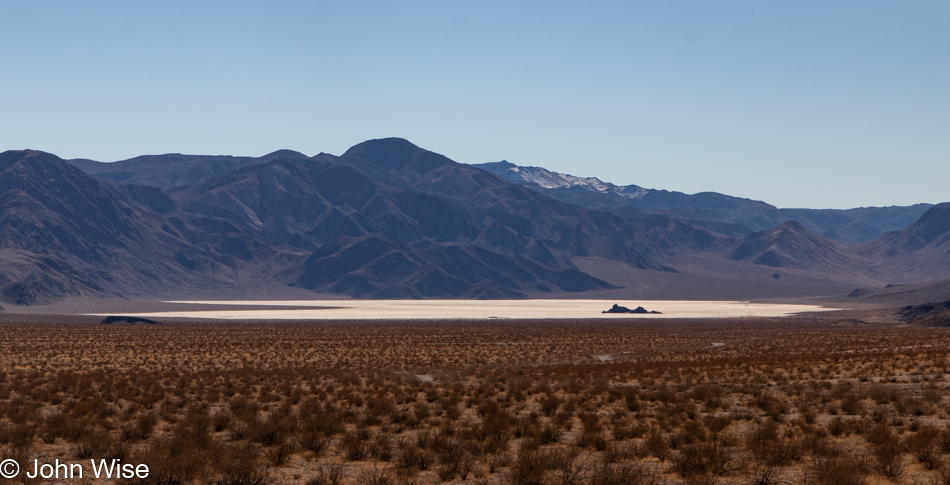
There it is, Racetrack Playa, home of the sailing stones.
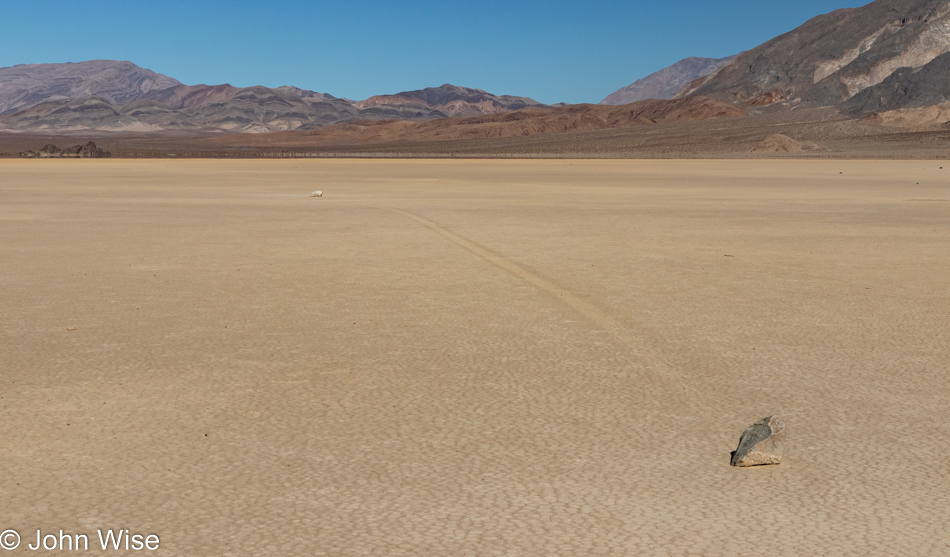
For years, mystery surrounded how these rocks were sailing across this dry lake bottom. Of course, aliens must have played a role, but the truth was finally confirmed in 2014 that on winter days with just the right amount of rain, freezing temperatures that help form a thin ice layer and light winds, the conditions are such that even very heavy rocks have been filmed traveling at up to 15-feet per minute.
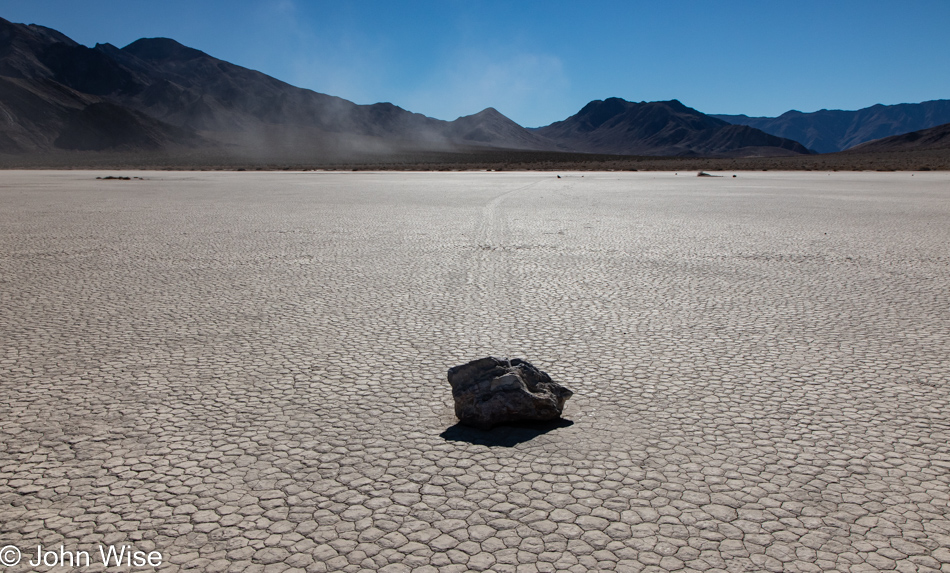
We only have an hour or so out here, and while we could have been happy with a mere 15 minutes, we’d also like to remain all day just waiting for one of those little green men to materialize and nudge one of these rocks forward.
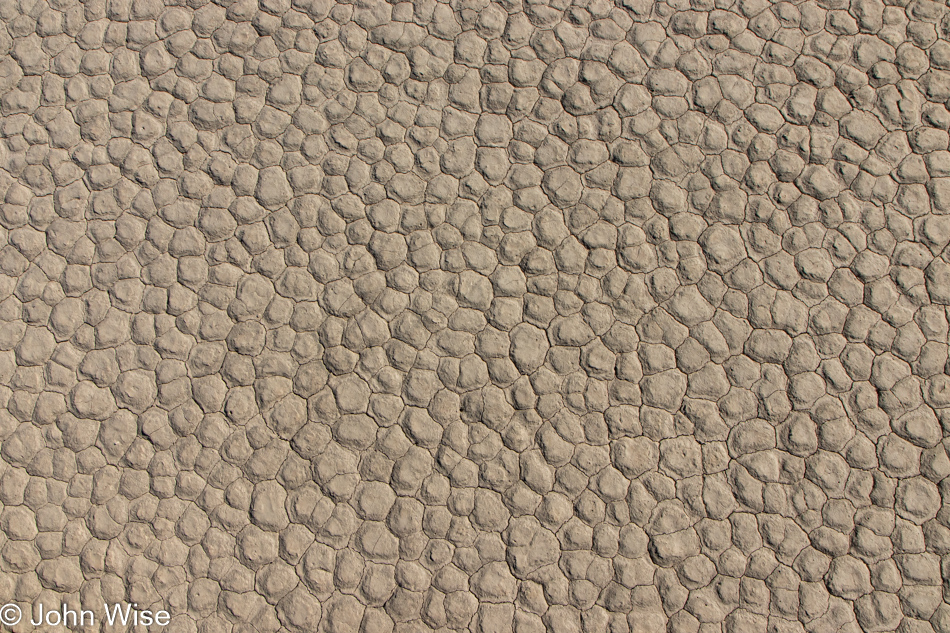
This “elephant skin” that is the floor of the Playa is a massive series of hexagonal polygons formed in the clay. If you are interested in more details about the processes that have created this amazing environment, there’s plenty more info on the internet.
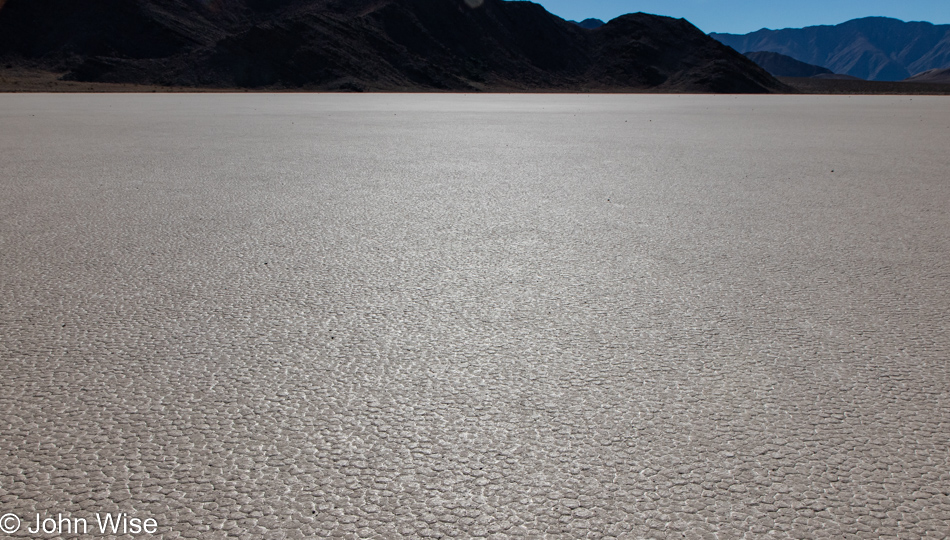
The playa is nearly perfectly flat, with the north side rising only 1.5 inches over the 2.8-mile length of the lake bed.

That’s right, these rocks can make turns, change direction, and even fall into each other’s tracks to travel with one another.

Welcome to the Grandstand, jutting right out of the northern end of the Playa.
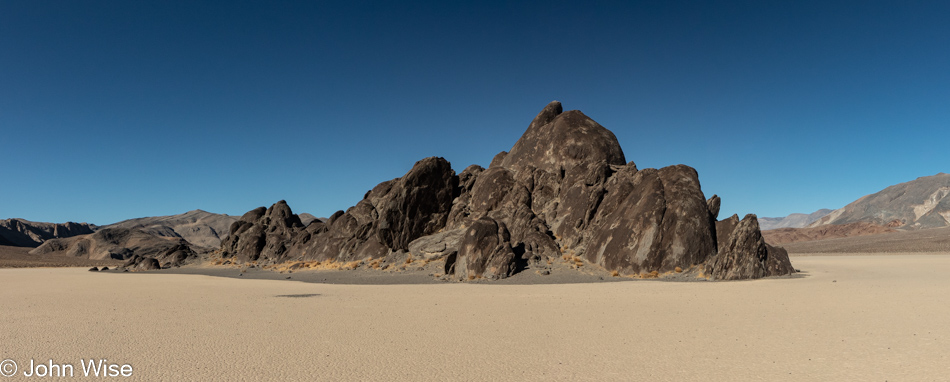
We walked around it and over the saddle but were most impressed with the lichen growing on the northeast-facing rocks.

Sadly, while I made efforts to only show Racetrack Playa in its perfection, some people do not care about how others will visit this remote site. Out of view are the impressions of tire tracks created by young men who feel compelled to drive out on the Playa, perform donuts, and race from one end to the other with no regard for the damage they leave or the time it takes for this complex ecosystem to repair itself. The vandalism by somebody’s off-road vehicle occurred in 2016, six years ago!
But drivers are not the only culprits, as I’ve read of photographers who’ll move rocks far away from their tracks to stop other photographers from being able to capture the same image in order to give their own photographs more value. We are a sad and tragic species with an education barely higher than the clay that makes up the ground here.
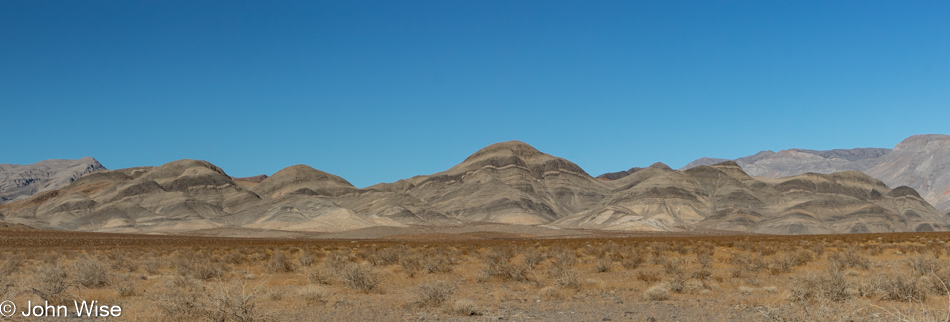
Good thing the earth doesn’t need us and has proven to humans that it has created everything that has real value, like dirt, plants, air, water, animals, and even us. Should we disappear from this environment, nothing would be lost except the harm we are able to commit upon each other and the ecosystems that support our lives. This incredible day is not another day for me to spend endless paragraphs lamenting the state of things; we are here for the glorious beauty that enthralls these two tree-huggers out to witness the extraordinary.
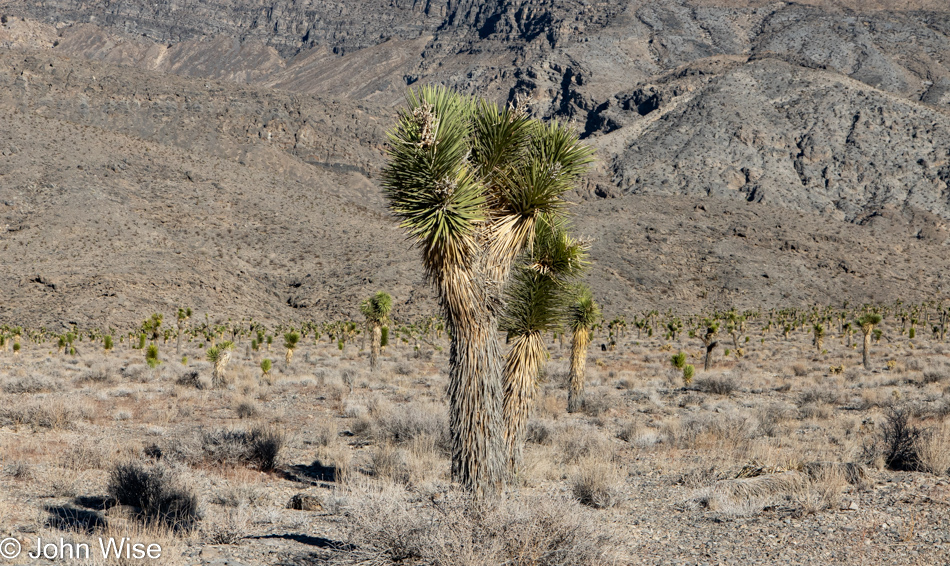
With that, we jumped out of the Jeep, ran over to the nearest Joshua Tree, and hugged it until we felt nature understood us.
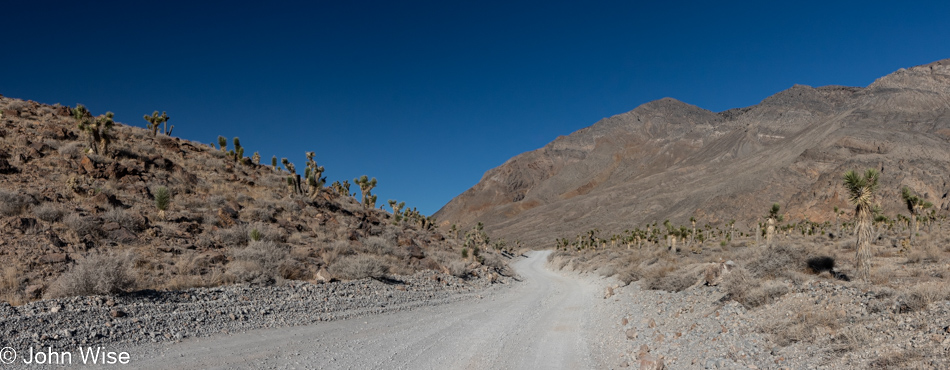
We passed a woman on a bike earlier on our way to the Racetrack, and we just passed her again as we were leaving. Our guide stopped this time and asked if she needed anything, “Nope, but thanks for asking,” was her polite answer, and so we drove on, but not without thinking about this woman’s tenacity.
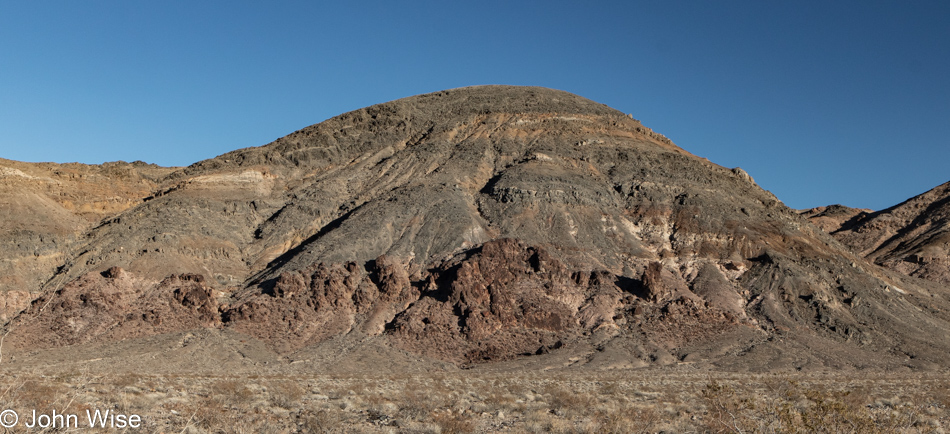
Deserts are beautiful places of earth stripped of masks, thus allowing us to see the naked geological forms not obscured by forests or oceans. They could also be the place and occasion for stripping away our facades and allowing the desert within us to be seen and exposed. As people stand before a raw and punishing nature, there is no human status, elegance, or charisma that means a thing to the reality of desert austerity, unable to fathom one’s self-importance. We should be humbled by the incredible fact that we are alive, and if we are truly fortunate, we can bring ourselves to places not enjoyed by everyone.
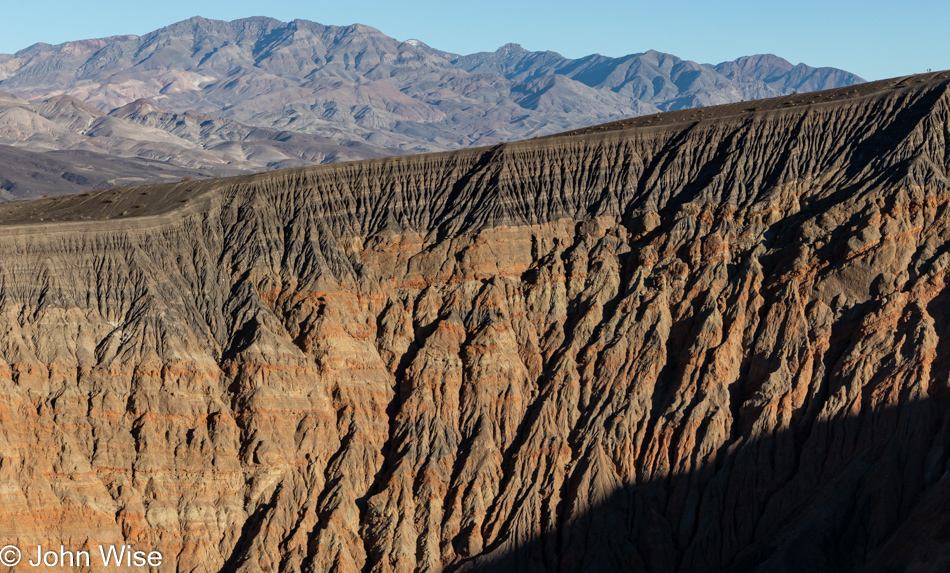
We are looking into Ubehebe Crater at a moment in the day when the bottom of the crater is in a dark shadow, not the best condition for photographs. This is our last stop of the tour into the north of Death Valley, and tragically, we only have about 15 minutes here before heading back to Furnace Creek, but now we know that there’s a paved road that brings visitors right to the rim. Next time, we’ll hike the perimeter or maybe even consider the steep trail down into the depths of this massive hole that was created by a steam-induced explosion.

Well, that was stunning, astonishing, inspiring, wonderful, and a multitude of other superlatives that should be hauled out to paint our experiential memories of what the day brought to our senses. Now it’s time to bask in those impressions and try to cement them into our personal catalog of recollections.
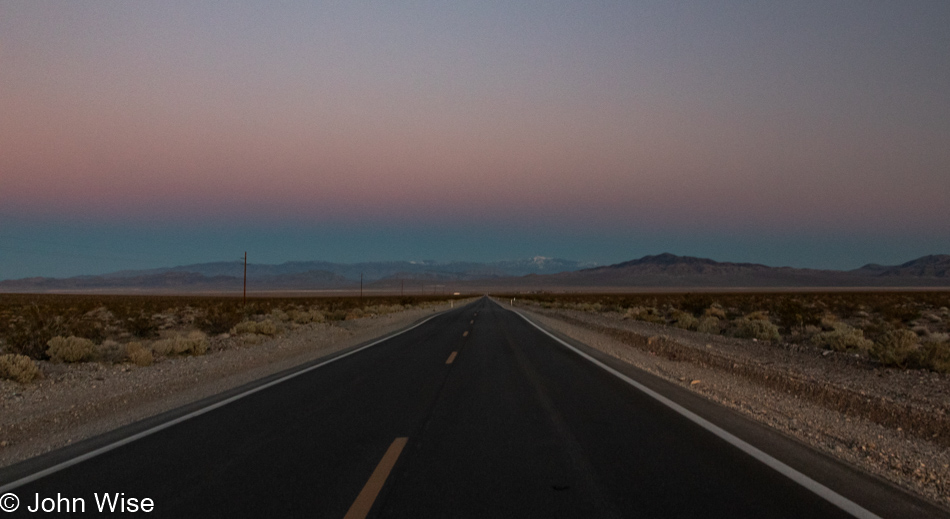
This is the opposite view of driving into the sunset as we drive into the night.
If you want to know the outcome of tomorrow,
Pray consult the blog post related to the following day.